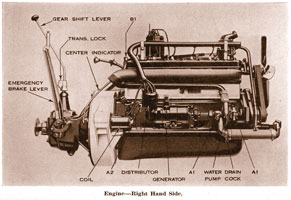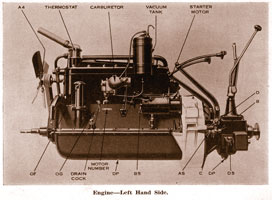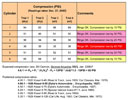
The Initial Freshening
Go to <Last, Summary, Next>Engine—Compression Test

 The Kissel Model 6-55 advanced six-cylinder engine |
 |
 |
| COMPRESSION: A 1920's "Hastings Piston Rings" compression tester manufactured by E. A. Stromberg Co., Chicago (left). A table showing results of a compression test on Bugsby (right). |
Lynn wants to perform a compression test on Bugsby's engine. A compression test is a noninvasive way of getting information about the condition of engine valves and piston rings. There's just one problem. The spark plug hole adapter on Lynn's compression tester that he's been using since the 1960's is way too small. It just falls right through the huge 7/8" spark plug hole in Bugsby.
After failing to locate a suitable tester by searching for new equipment, Lynn finally buys a used, 1920's nickel plated tester on eBay. Using this tester he performs four complete tests for each cylinder, two dry tests (no oil added) and two tests where he's squirted motor oil into the cylinder. If the piston rings are badly warn, oil squirted into the cylinders will seal the leak and give a higher compression reading. The difference between the dry and oil compression tests will indicate if there are problems with the rings.
What compression should we expect from Bugsby if everything is in perfect shape? A table in Lynn's 1927 Dyke's Automobile Encyclopedia indicates that a 1926 Kissel Model 6-55 has 4.6:1 compression ratio. Lynn assumes that his 1924 engine has the same compression ratio.
As noted in Bill Cannon's "Viewpoint" article in the January 2006 issue of the car restoration journal Skinned Nuckles (Vol. 30, No. 6), adiabatic compression is a reasonable model for computing the expected compression test pressure. (A gas heats up as it is compressed. Adiabatic compression means that no loss of the heat from the gas is assumed. Another assumption that would give a much lower predicted pressure is isothermal compression where the gas is assumed to be at constant temperature.) The resulting gauge pressure (absolute pressure minus atmospheric pressure) is computed in the formula noted at the bottom of the compression test table, above. Lynn expects that Bugsby will exhibit about 80 PSI (pounds per square inch) if everything were in good condition.
Examining the compression test table, one sees virtually no difference between the dry and oil tests. That's great! It says that the piston rings are likely sealing well. This also confirms Lynn's visual inspection from the bottom with the oil pan off where the cylinder walls appeared smooth and clear.
However cylinder #4 shows a definite problem. The likely cause is that one or both valves are pitted and not sealing well. Dave Arnold did tell Lynn that cylinders #3 and #4 can often have a problem with cracked valve seats. These two valves share a common exhaust manifold port and this configuration apparently puts extra stress on the valve seats (in the engine block). Lynn is worried now that he's got a cracked block around the exhaust valve seats of cylinder #4. This adverse result alone is enough to warrant removing the cylinder head and having a closer inspection.
Note that cylinders #1 and #6 show higher compressions than the other cylinders, but the compression is still short of the predicted compression by 12-16 PSI.
The symmetry of high readings on cylinders #1 and #6, the normal readings on #2 and #5, and the problem with #4, does seem odd to Lynn. What could cause symmetric, rather than random, variations between the cylinders? Is this characteristic of the design of the engine and the shared exhaust manifold port on cylinders #3 and #4? Lynn doesn't know but flags this observation for future consideration.
Contact
 with your comments or questions
with your comments or questionsCopyright © 2018 Lynn Kissel
Last updated: May 24, 2009